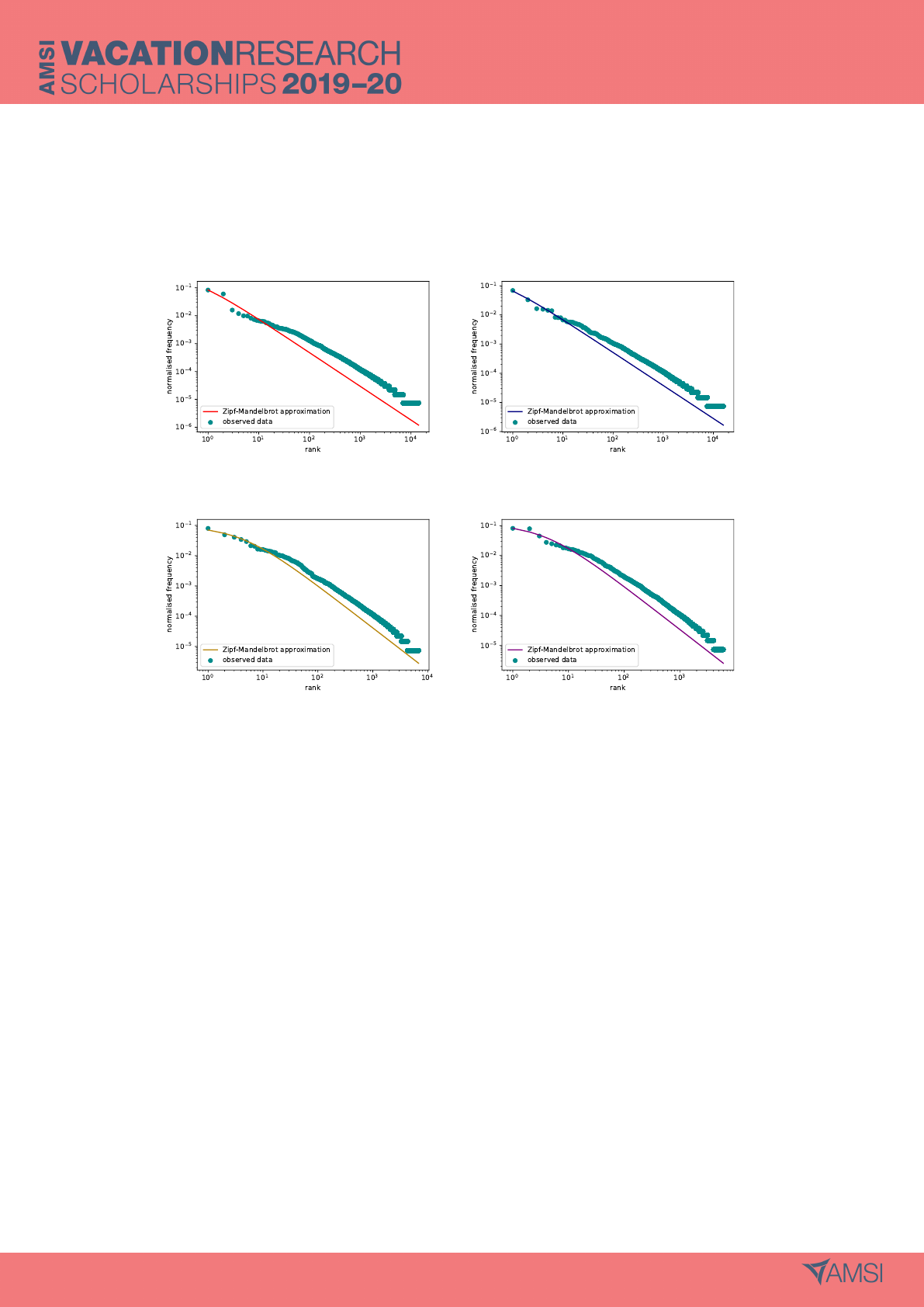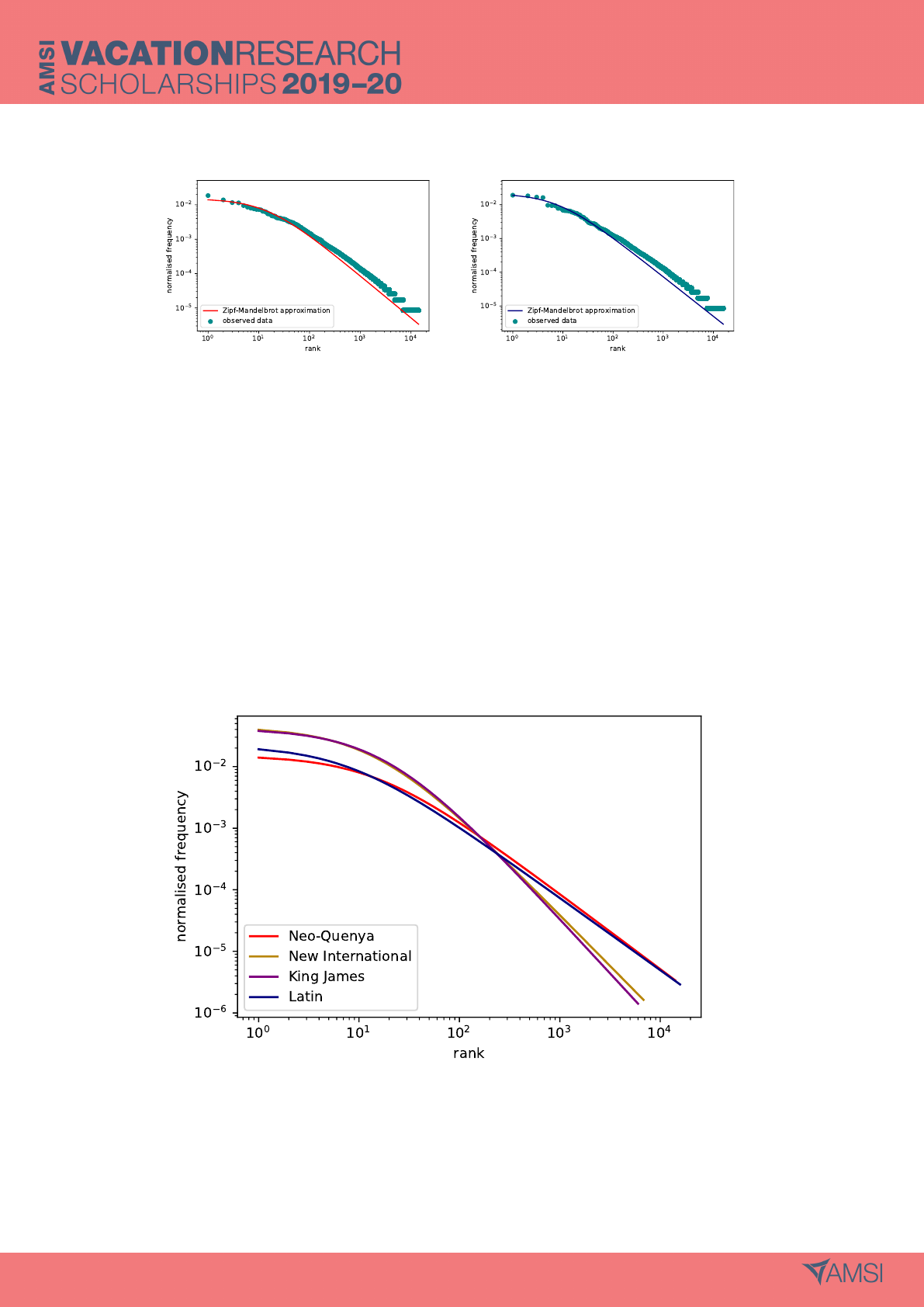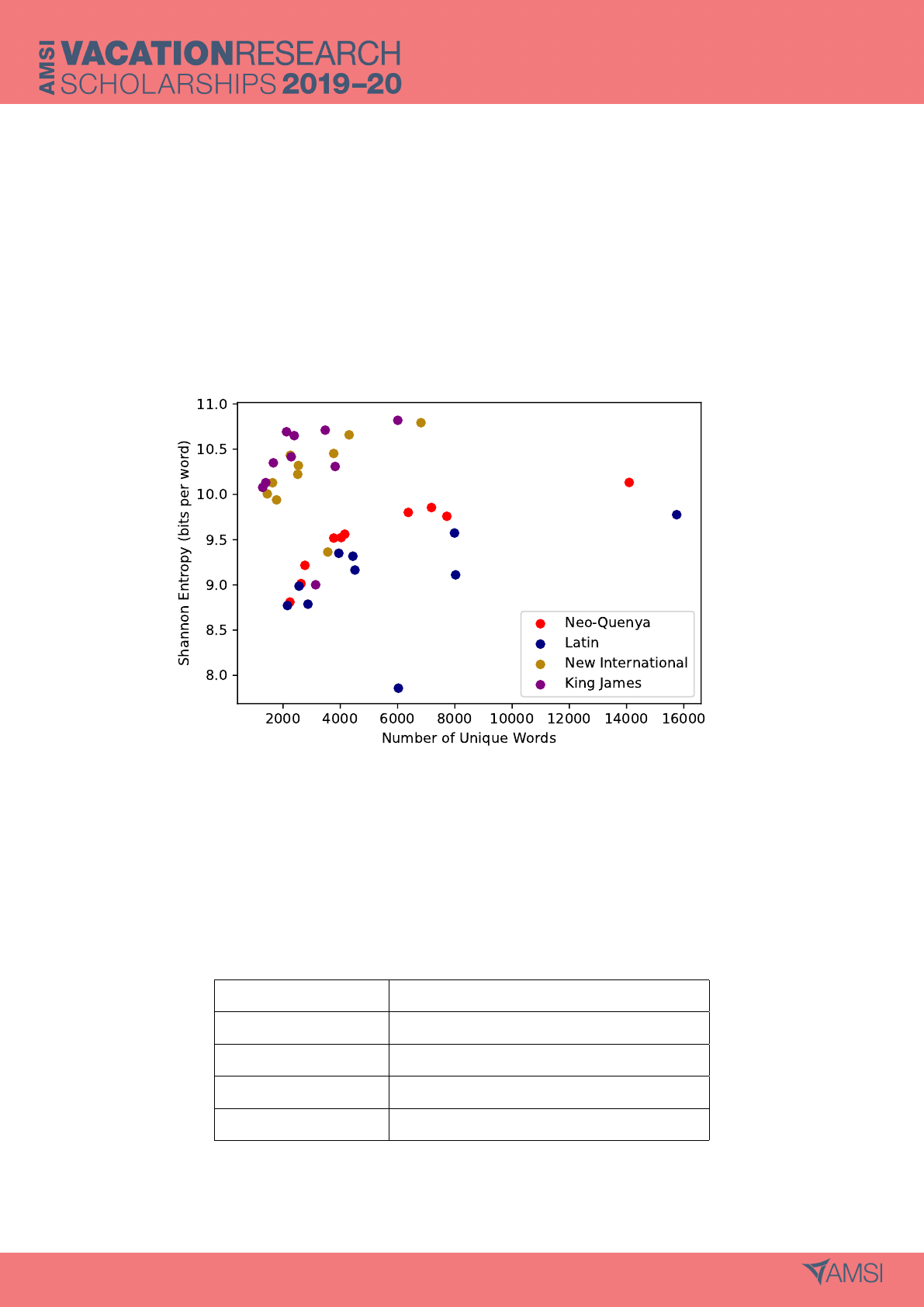
Information Entropy of Constructed
Languages
Megan Crossing
Supervised by Professor Matthew Roughan
The University of Adelaide
Vacation Research Scholarships are funded jointly by the Department of Education and
Training and the Australian Mathematical Sciences Institute.

Contents
1 Introduction 1
1.1 Statement of Authorship . . . . . . . . . . . . . . . . . . . . . . . . . . . . . . . . . . . 1
2 Quenya: Its Brief History 2
3 Information Entropy 2
3.1 Shannon Entropy . . . . . . . . . . . . . . . . . . . . . . . . . . . . . . . . . . . . . . . 2
3.2 Zipf-Mandelbrot Distribution . . . . . . . . . . . . . . . . . . . . . . . . . . . . . . . . 3
4 The Process 3
4.1 Text selection . . . . . . . . . . . . . . . . . . . . . . . . . . . . . . . . . . . . . . . . . 3
4.2 Pre-Processing . . . . . . . . . . . . . . . . . . . . . . . . . . . . . . . . . . . . . . . . 4
4.3 Generating Results . . . . . . . . . . . . . . . . . . . . . . . . . . . . . . . . . . . . . . 5
5 Results 6
5.1 Zipf-Mandelbrot Approximations . . . . . . . . . . . . . . . . . . . . . . . . . . . . . . 6
5.2 Shannon Entropy . . . . . . . . . . . . . . . . . . . . . . . . . . . . . . . . . . . . . . . 9
6 Discussion 12
6.1 A Dichotomy in Languages . . . . . . . . . . . . . . . . . . . . . . . . . . . . . . . . . 12
6.2 Potential Extentions . . . . . . . . . . . . . . . . . . . . . . . . . . . . . . . . . . . . . 13
7 Conclusion 14
Appendices 16
A Zipf-Mandelbrot Comparisons 16
B Total and Unique Word Counts for Four New Testament Translations 17
i

Abstract
This project investigates entropic differences between natural and constructed languages, with a
focus on the Neo-Quenya translation of the New Testament. Using the Natural Language Processing
Toolkit in Python, we found the Shannon entropies and Zipf-Mandelbrot distributions of four
translations of the New Testament. The translations used were the King James Version, the New
International Version, the Biblia Sacra juxta Vulgatam Clementinam (Latin), and the Neo-Quenya.
The study found that the entropies of the Latin and Neo-Quenya translations were generally lower
than the two English translations, that the Zipf-Mandelbrot distributions of the English translations
were near identical, and that the Zipf-Mandelbrot distributions of the Latin and Neo-Quenya were,
whilst similar, less similar than the two English translations.
1 Introduction
There are three main types of constructed languages:
• Auxiliary languages
• Engineered languages
• Fictional languages
Auxiliary languages, such as Esperanto, are used to aid global communication and engineered lan-
guages, such as Lobjang, are created to perform particular experiments. The third, fictional languages,
are created to provide verisimilitude in fantasy books (such as Lord of the Rings) and TV series (such
as Game of Thrones or Star Trek). They are the focus of this paper.
Unlike engineered or auxiliary languages, fictional languages are created to be believable. Presum-
ably, a good fictional language will be statistically similar to natural languages. We can assess this
using the lens of information theory.
Information entropy is a topic that has been often studied since its initiation in 1948 by Claude
Shannon (Gleick 2011). Since this time, the entropy of many natural languages has been analysed
(Barnard 1955; Bentz 2017), but there has been little investigation into the entropy of constructed
languages.
In this paper, we analyse the Quenya translation of the New Testament.
1.1 Statement of Authorship
Megan Crossing processed the texts; developed the Python code; produced, reported and interpreted
the results; and wrote this report.
1

Professor Matthew Roughan initiated and supervised the project, and proofread this report.
2 Quenya: Its Brief History
Quenya was one of 9 Elvish dialects developed by J.R.R. Tolkien for use in his Lord of the Rings
universe. He began working on it in 1915, and it is generally agreed on that the language was in its
final form by 1954, when he published The Fellowship of the Ring. (Fauskanger n.d.)
As a linguist, Tolkien put a lot of time and effort into making his languages as realistic as possible,
giving many of his words complete etymologies. For example, Tolkien writes that the word Quenya
is probably derived from the same stem as Quendi (Elves), and thus means Elvish. However, he also
writes that the stem may instead be ‘quet’, and not ‘quen’, meaning Quendi translates as ‘those who
speak with voices’, and Quenya as ‘speech’. (Tolkien 1994) Not only did Tolkien give his languages a
history, he also incorporated the uncertainty he observed in natural languages.
Since Tolkien’s creation of Quenya, various people have attempted to translate works into it
(Derdzinski n.d.; I Vinya Vere: The New Testament in Neo-Quenya 2015). Despite the years Tolkien
put into developing Quenya, its vocabulary stretches only so far. Translators have developed ne-
ologisms to deal with this, creating Neo-Quenya. The work investigated here is the Neo-Quenya
translation of the New Testament (I Vinya Vere: The New Testament in Neo-Quenya 2015).
So, natural languages have evolved over hundreds of thousands of years by hundreds of thousands
of people. Tolkien’s Quenya, whilst having a mimicked evolution, has been constructed over the last
hundred with only one main contributor. With this in mind, it will be interesting to see if any hidden
differences remain between Quenya and natural languages.
3 Information Entropy
3.1 Shannon Entropy
Here, information entropy was found using Shannon’s entropy (Shannon 1948), which is given by the
following equation:
H(X) = −
N
X
k=1
p(k) log
2
p(k).
This gives the information entropy (H(X), measured in bits per token) of a discrete random variable,
X, that exists over a distribution of 1 to N . In our case, we are finding the word entropies for four
2

translations of the New Testament. Thus, for a given translation, X is the set of all words in the New
Testament, N is the number of unique words, and p(k) is the probability of the k
(
th) word occuring.
3.2 Zipf-Mandelbrot Distribution
The Zipf-Mandelbrot distribution (Zipf 1949) is a generalisation of the Zipf distribution. The Zipf
distribution was designed to model observed patterns in the probability distributions of natural lan-
guages:
f(k|N, s) =
1
k
s
P
N
n=1
n
−s
,
where f is the probability distribution of words in a natural language, N is the vocabulary size of the
language, k is the rank of a word, k = 1 being the most frequent word, and s is some parameter.
This paper uses the later modification by Benoit Mandelbrot (Mandelbrot 1966), as it better models
the lower ranked words. It has the following probability mass function:
f(k|N, s, q) =
1
(k + q)
s
P
N
n=1
(n + q)
−s
.
This is similar to the Zipf distribution, with the only difference being the additional parameter q. In
the case where q = 0, the Zipf and Zipf-Mandelbrot distributions are identical.
4 The Process
4.1 Text selection
The longest accessible piece of any artistic constructed language text is, as far as we are aware,
Fauskanger’s (2015) translation of the New Testament into Neo-Quenya.
For comparison, two English translations (the New International Version (1978) and the King
James Version (2004)) were also analysed, along with the Latin Biblia Sacra juxta Vulgatam Cle-
mantinam (1592). The New International Version is standard and commonly used. The King James
Version was revised in 2004, but is based off the Authorised King James Version, which was translated
in 1611. The King James was chosen as its writing style is far more archaic than the New International
Version.
The Biblia Sacra is a revised version of the original AD 382 translation into Latin. This Latin
translation was chosen for two reasons. Firstly, Quenya grammar is partially based off Latin grammar.
3

Secondly, Tolkien created Quenya to be the ‘Latin’ of Elvish – used more for scholarship and law than
for everyday writing and conversation. Perhaps Quenya and 16th century Ecclesiastical Latin lend
themselves to similar writing styles.
4.2 Pre-Processing
The Neo-Quenya translation was downloaded as Word documents of the individual chapters (I Vinya
Vere: The New Testament in Neo-Quenya 2015). These included alternating paragraphs of both the
Quenya and its back translation. A find and replace search in Word was used to remove the back
translation paragraphs, along with the translation notes.
The three natural language translations were downloaded as pdf documents (Biblia Sacra juxta
Vulgatam Clementinam 1592; King James Version 2004; New International Version 1978), and copied
into word documents for pre-processing, where the Old Testament, Psalms and Proverbs were removed.
Headers were also removed.
In the Neo-Quenya translation, the Gospel of Mark Chapter 16, Verses 9-20 were not included. This
is not due to an incomplete translation, but simply to the fact that these verses were not contained in
the earlier manuscripts (The Holy Bible: New International Version with concise bible encyclopaedia
2007, Mark 16:8-9). Consequently, these verses were removed from the New International Version,
the King James Version and the Biblia Sacra.
The translations were then combined and split into separate text documents containing 10 sections
for individual analysis:
• New Testament
– Gospels
∗ Gospel of Matthew
∗ Gospel of Mark
∗ Gospel of Luke
∗ Gospel of John
– Acts of the Apostles
– Letters
∗ Paul’s Letters
– Revelation
4

The New International and King James translations did not attribute the authorship of the Letters to
the Hebrews to Paul, whereas the Biblia Sacra did. The Neo-Quenya translation did not specify the
authorship of any of its letters. Due to the variation in writing style (“Non-Pauline Letters” 2007),
the Letters to the Hebrews were not included in segment containing Paul’s Letters.
4.3 Generating Results
Each section was uploaded into Python (Van Rossum and Drake 2009) as four text files (one for each
translation), and the following processing was performed:
1. The text was tokenised into single words. Special characters (such as accented letters) were
converted to normal characters (i.e. non-accented). Upper case letters were converted to lower
case. Non-alphabetic characters were then removed.
2. The total number of words was counted and recorded. [appendix B, table 5]
3. Word frequencies were calculated and ordered from most to least common. The total number of
unique words was recorded. [appendix B, table 6]
4. A list of ranks of the same length as the vocabulary size was created, with 1 being the most
common word.
5. The frequencies were stored in an independent list and normalised.
6. Zipf-Mandelbrot parameters were found and a curve was fitted using the Python’s curve fit
package (Virtanen 2020).
7. The Shannon entropy was calculated for each translation.
5

5 Results
5.1 Zipf-Mandelbrot Approximations
(a) Neo-Quenya (b) Latin
(c) New International (d) King James
Figure 1: Rank against frequency probability distributions with fitted Zipf-Mandelbrot curves for four
New Testament translations. The Zipf-Mandelbrot curve fits the New International translation well.
The fit is moderate for the King James and Latin translations, and very poor for the Neo-Quenya.
As shown in figure 1, the Zipf-Mandelbrot curve fits nicely for the New International translation,
less so for the Latin and the King James, and very poorly for the Neo-Quenya. This problem was
consistent across most subsections. There were some segments where the Zipf-Mandelbrot curve fit
the Latin distribution well, but none for the Neo-Quenya translation. An implication of this is that
the Zipf-Mandelbrot curve is a poor representation of the probability distribution of Neo-Quenya word
frequencies, and so the entropy of the Zipf-Mandelbrot curve was not considered.
The ill-fit of the Zipf-Mandelbrot curve for the Neo-Quenya word frequencies appears to be pri-
marily caused by the two most frequent words. In all four of the translations, these words seem to
deviate slightly from the curve, but it appears that this is more evident in the Latin and Neo-Quenya
translations. In order to allow for easy comparison between probability distributions, the first two
6

most frequent words of each language were removed, and the Zipf-Mandelbrot curves refitted. For
most segments, the words removed are given by table 1.
Table 1: Two most common words in each translation of the NewTestament. These words were
removed for further comparisons using the Zipf-Mandelbrot distribution.
Translation Excluded Word Word Type
Neo-Quenya i (the; that) definite article; relative pronoun/conjunction
ar (and; day) conjunction; noun
Latin et (and) conjunction
in (in; on) preposition
New International the definite article
and conjunction
King James and conjunction
the definite article
As disclosed by table 1, the two most common words in Neo-Quenya have at least two uses each.
In Neo-Quenya, ‘i’ represents not only the definite article (the), but also a common pronoun and
conjunction (that). Likewise, ‘ar’ is both a common conjunction (and), and a noun (day) that may
be assumed to have fairly regular use in the New Testament. Latin, perhaps, deviates because it is a
language lacking a definite article in ordinary use.
The words excluded were identical across most segments, with some exceptions. A pronoun, ‘you’
replaces ‘and’ in the New International Gospel of John. In Letters and Paul’s Letters, Latin and Neo-
Quenya are consistent, but the removed words for the New International and King James translations
are ‘the’, ‘to’ and ‘the’, ‘of’ respectively. On a lesser note, the ranks of ‘ar’ and ‘i’ are inverted in
the Neo-Quenya Gospel of Mark, as are those of ‘and’ and ‘the’ in the King James Gospel of John.
7

(a) Neo-Quenya (b) Latin
Figure 2: Rank against frequency probability distributions with fitted Zipf-Mandelbrot Curves for
Neo-Quenya and Latin New Testament translations, with the two most frequent words removed from
the data.
Figure 2 shows the Zipf-Mandelbrot curves fitted to the rank-frequency distributions of Latin and
Neo-Quenya with the two most common words removed. Evidently, figure 2 demonstrates a far better
fit for Latin and Neo-Quenya than figure 1. This allows for the comparison between Zipf-Mandelbrot
curves in figure 3.
Figure 3: Zipf-Mandelbrot approximations of rank-frequency probability distributions for four New
Testament translations with the two most common words removed from the data. There is a distinct
split between the English and non-English translations.
8

Figure 3 presents an immediate dichotomy into English and non-English translations. The English
distributions are almost identical. The Latin and Neo-Quenya distributions are not quite so similar for
higher frequency words, but are very similar for lower frequency words. This dichotomy is consistent
across the Zipf-Mandelbrot comparisons for all sections [appendix A, figure 6].
Table 2: Parameters s and q for the Zipf-Mandelbrot probability distributions of four New Testament
translations with the two most common words removed from each
Translation s q
Neo-Quenya 1.22 14.62
Biblia Sacra 1.17 7.84
King James 1.77 18.14
New International 1.66 14.61
The parameters, s and q, for each of the Zipf-Mandelbrot distributions in figure 3 are given in table
2. Again, the English distributions have similar parameters, as do the Latin and the Neo-Quenya
5.2 Shannon Entropy
Table 3: Shannon entropies of each segment for the four New Testament translations.
Segment Neo-Quenya Biblia Sacra King James New International
New Testament 10.13 9.78 10.79 10.82
Gospels 9.76 9.57 10.45 10.71
Matthew 9.52 9.35 10.43 10.69
Mark 9.22 8.79 9.94 10.35
Luke 9.56 9.32 10.32 10.65
John 9.01 8.99 10.13 10.13
Acts 9.52 9.16 10.22 10.42
Letters 9.86 9.11 10.66 10.31
Paul’s Letters 9.80 7.86 9.36 9.00
Revelation 8.81 8.77 10.01 10.08
Table 3 displays the Shannon entropies for each of the ten segments. Considering all translations,
the entropies sit between 7.86 bits per word (Biblia Sacra Paul’s Letters) and 10.82 bits per word
9

(New International New Testament). Generally, the English translations have similar entropies, as do
the Latin and the Elvish. Although the King James Version usually has the highest entropies, there is
some overlap: the New International Version has the highest entropy for Letters (10.66 bits per word)
and Paul’s Letters (9.36 bits per word). The Neo-Quenya entropies remain sandwiched between those
of the Biblia Sacra and the English translations, except in Paul’s Letters, where it is higher than the
King James entropy. The Latin translation always has the lowest entropy.
Figure 4: Box plots of Shannon entropies for the segments of four New Testament translations. The
box plots for the King James and New International translations are similar. Although closer to each
other than to the English translations, the box plots for the Neo-Quenya and Latin translations are
not similar. The Neo-Quenya translation has no outlier.
The notched box plots were generated in order to give some indication of the spread of entropies
across different writing styles. In figure 4, the notches represent the 95% confidence interval of the
median. As in other areas, the dichotomy into English and non-English translations is evident. Upon
closer investigation, differences emerge. The medians of the English translations clearly fall within
each other’s 95% confidence intervals, and so these distributions (and thus the translations) can be
said to be statistically similar in terms of entropy. The same cannot be said of the Neo-Quenya and
Latin translations. Whilst their entropies and Zipf-Mandelbrot distributions are usually similar, the
Neo-Quenya and Biblia Sacra translations of the New Testament are statistically different. Further-
10

more, the Neo-Quenya entropies have the smallest range when outliers are included. This suggests
that as a fictional language, Quenya lends itself to less diversity in the way it can be used.
As demonstrated by Bentz et al. (2017), vocabulary size has a strong impact on entropy. Poten-
tially, the variation observed amoungst the box plots is merely due to fluctuations in the number of
unique words in each segment. Consquently, we investigated the possibility that variation in entropy
was due to vocabulary size, rather than writing style.
Figure 5: Scatter plot of entropy against vocabulary size for each New Testament translation. Only
weak correlations are present for the natural language translations. Again, the dichotomy between
English and non-English translations may be observed in the two clusters.
Table 4: Pearson’s correlation coefficient for relationship between entropy and vocabulary size in four
New Testament translations.
Translation Pearson’s Correlation Coefficient
Neo-Quenya 0.853
Biblia Sacra 0.471
King James 0.232
New International 0.509
11

To confirm the low impact of vocabulary size, the vocabulary size of each segment was plotted
against its Shannon entropy (figure 5). No strong correlations between entropy and vocabulary size
are evident. However, the Pearson’s correlation coefficients in table 4 give deeper insight. Entropy and
vocabulary size are poorly correlated for the New International, King James and Latin translations,
with coefficients of 0.51, 0.23 and 0.47 respectively. Whilst increasing vocabulary size leads to a general
increase in entropy, this trend is not reliable for any of the natural language translations. Conversely,
the Neo-Quenya translation has a correlation coefficient of 0.85, suggesting that vocabulary size has
a strong impact on the Neo-Quenya entropies. This suggests an entropic divide between Quenya and
the natural languages.
6 Discussion
6.1 A Dichotomy in Languages
Generally, the results demonstrated that the Neo-Quenya New Testament is not at all similar to either
of the English translations, and that it is closer to the Latin translation. Both the entropy box plots
(figure 4) and the Zipf-Mandelbrot comparisons (figure 3) demonstrated this split.
The segment entropy box plots (figure 4) displayed an evident dichotomy. The similar distributions
of the King James and New International translations strongly indicate that their entropies are
statistically comparable despite great variety in writing style. Whilst the distributions of the Neo-
Quenya and Latin segment entropies were both lower than the English distributions, their box plots
were statistically dissimilar. The median for the Latin translation lay outside the 95% confidence
interval of the Neo-Quenya median and vice versa. The Neo-Quenya and the Latin may be dissimilar
due to the fact that they are different languages, or it may be because Latin is a natural language,
and Neo-Quenya is constructed. Comparisons with a greater variety of translations would be required
to support or negate either conclusion.
As has been observed above, the Zipf-Mandelbrot comparisons after the removal of the two most
common words displayed a clear dichotomy between the English and the non-English New Testament
translations (figure 3). The Zipf-Mandelbrot distributions for the non-English translations started
lower, but ended higher than the English. This was reflected in the differences between the total
number of words and the number of unique words in each section [appendix B]. For each section, the
English translations had by far the higher word count [appendix B, table 5], but when the number
12

of unique words was tabulated [appendix B, table 6], it was found that they had fewer unique words
than the non-English translations. Hence, this leads to higher frequencies in the more common words
and a steep drop-off as the word rank is increased. The most obvious explanation for this is inflection.
Inflection in language is essentially a categorisation of grammar structure and the importance of
word order. English, as a weakly inflected language, is heavily dependent on word order, articles,
prepositions, pronouns and auxiliary verbs in order to correctly convey the information in a sentence.
On the other hand, heavily inflected languages (such as Quenya and Latin), usually indicate this
information by changing noun and verb endings. In an extreme example:
English: The dog gives a dog to a dog.
Latin: canis canem cani dat.
Here, the different endings to ‘canis’ (dog) indicate which dog it is. The ‘-is’ ending denotes the dog
doing the action, the ‘-em’ ending denotes the dog having the action done to it, and the ‘-i’ ending
denotes the dog having something given to it. A similar thing occurs with verb person, number, mood,
tense and aspect. Consequently, inflected languages use fewer words of a greater variety to convey the
same information.
It is also worth noting that, as demonstrated by the entropy table (figure 3) and box plot (figure
4), heavily inflected languages appear to have lower Shannon entropies than weakly inflected ones.
However, in order to draw a confident conclusion, more translations would need to be analysed.
6.2 Potential Extentions
The possible extensions of this project are many and varied. Ideally, comparisons would be performed
between the Neo-Quenya and at least 30 other natural languages, to allow for some indication of
statistical significance. A range of inflected and non-inflected languages, as well as non-Indo-European
ones could be included, to investigate the relationship between Quenya, languages it is based off (e.g.
Latin, Finish and Ancient Greek) (Fauskanger n.d.) and languages that have no deliberate connection
(e.g. Mandarin or Wiradjuri). Ideally, the entropies would be calculated in such a way as to make
strongly and weakly inflected languages comparable.
Whilst better than letter entropy, word entropy is far from perfect in measuring the entropy of
a language. The selection of a word as the token of measure, causes a direct split between heavily
and weakly inflected languages. Potentially, the ideal measure for entropy in language would be the
morpheme. This would designate the set of tokens as being the set of smallest units of meaning within
a language, allowing easier comparison between Quenya and a variety of languages.
13

A similar investigation could be performed upon the Klingon translation of Hamlet, or the Bible,
once it is complete. The Bible would be ideal, as it would allow for comparison between Quenya
and Klingon. It would be interesting to see if the two constructed languages displayed any consistent
differences when compared with natural languages, as they were constructed in very different ways.
7 Conclusion
In summary, Quenya differs significantly from English in terms of information entropy, but is similar
to Latin. Potentially, this is due to the similar levels of inflection between Latin and Quenya. The
section entropies of Neo-Quenya are more clustered than those of both the English and the Latin
translations, suggesting that the entropy of fictional languages differs less across different writing styles.
Additionally, the notched box plots demonstrate that the entropies of the two English tranlsations
are statistically similar, and that those of the Neo-Quenya and Latin translations are not. However,
a greater number and variety of translations would be required in order to add confidence to these
conclusions.
Bibliography
Barnard, G.A. (1955). “Statistical Calculation of Word Entropies for Four Western Languages”. In:
IRE Transactions - Information Theory 1, pp. 49–53.
Bentz, C. et al. (2017). “The entropy of words - learnability and expressivity across more than 1000
languages”. In: Entropy 19, p. 275.
Biblia Sacra juxta Vulgatam Clementinam (1592). Trans. by Jerome. https://www.wilbourhall.
org/pdfs/vulgate.pdf. first translated AD 382.
Derdzinski, R, ed. (n.d.). Quenta Silmarillion Eldalambenen. http://www.elvish.org/gwaith/silmarillion
project.htm.
Fauskanger, H.K. (n.d.). Quenya - the ancient tongue.
Gleick, J. (2011). The information: a history, a theory, a flood. London: Fourth Estate.
I Vinya Vere: The New Testament in Neo-Quenya (2015). Trans. by H.K. Fauskanger. https://folk.
uib.no/hnohf/nqnt.htm.
King James Version (2004). www.turnbacktogod.com/king- james- bible-kjv- bible- as-pdf/.
first translated 1611.
14

Mandelbrot, B. (1966). “Information theory and psycholinguistics: a theory of words and frequencies”.
In: Readings in Mathematical Social Science. Ed. by P Lazafeld N Henry. Cambridge MA: MIT
Press.
New International Version (1978). www.turnbacktogod.com/wp-content/uploads/2011/02/NIV-
Bible-PDF.pdf.
“Non-Pauline Letters” (2007). In: Journal for the Study of the New Testament 29 (5), pp. 107–112.
Shannon, Claude (1948). “A mathematical theory of communication”. In: The Bell System Technical
Journal 27 (3), pp. 379–423.
The Holy Bible: New International Version with concise bible encyclopaedia (2007). Minto, N.S.W:
Bible Society in Australia.
Tolkien, J.R.R. (1994). “Quendi and Eldar”. In: The War of the Jewels. Ed. by C Tolkien. London:
Harper Collins.
Van Rossum, G. and F. L. Drake (2009). Python 3 Reference Manual. Scotts Valley, CA.
Virtanen, Pauli et al. (2020). “SciPy 1.0: Fundamental Algorithms for Scientific Computing in Python”.
In: Nature Methods.
Zipf, G.K. (1949). Human behaviour and the principle of least effore. Addison-Wesley Press.
15

Appendices
A Zipf-Mandelbrot Comparisons
(a) New Testament (b) Gospels (c) Gospel of Matthew
(d) Gospel of Mark (e) Gospel of Luke (f) Gospel of John
(g) Acts of the Apostles (h) Letters (i) Paul’s Letters
(j) Revelation
Figure 6: Zipf-Mandelbrot approximations for the frequency agaisnt rank distributions of the segments
of four New Testament translations. The two most common words have been removed from each
segment and translation.
16

B Total and Unique Word Counts for Four New Testament Trans-
lations
Table 5: Total number of words in each segment for four New Testament translations.
Segment Neo-Quenya Biblia Sacra King James New International
New Testament 136 384 126 575 174 422 180 279
Gospels 61 523 58 892 78 804 83 652
Matthew 17 364 16 553 22 569 23 690
Mark 11 006 10 151 13 537 14 917
Luke 18 990 18 090 24 128 25 945
John 14 163 14 098 18 570 19 100
Acts 18 492 16 785 22 917 24 249
Letters 47 649 42 409 61 411 60 388
Paul’s Letters 39 810 30 648 44 424 43 405
Revelation 8720 8489 11 290 11 990
Table 6: Number of unique words in each segment for four New Testament translations.
Segment Neo-Quenya Biblia Sacra King James New International
New Testament 14 092 15 752 6817 6007
Gospels 7721 7989 3768 3472
Matthew 3770 3946 2253 2120
Mark 2763 2868 1772 1659
Luke 4155 4439 2534 2389
John 2626 2557 1632 1393
Acts 4031 4510 2512 2284
Letters 7183 8028 4307 3820
Paul’s Letters 6374 6028 3562 3137
Revelation 2238 2152 1447 1287
17
